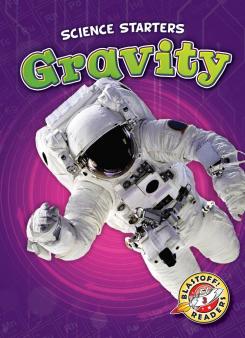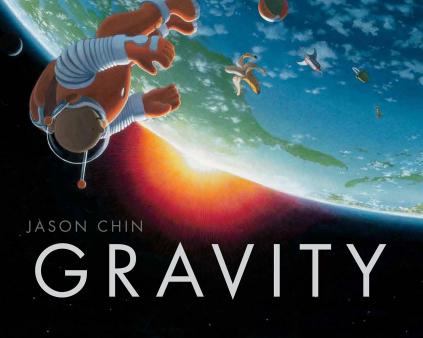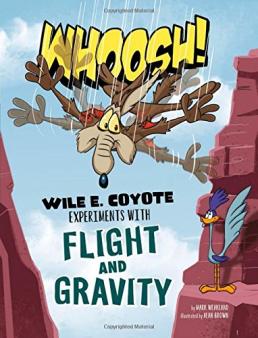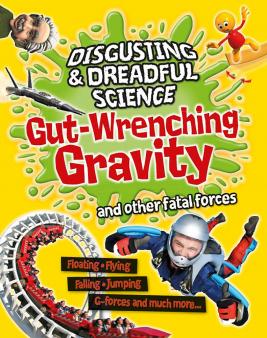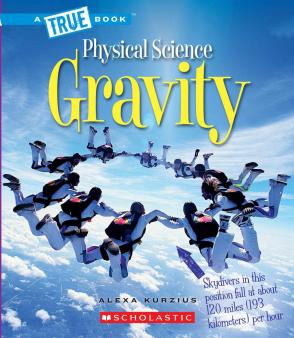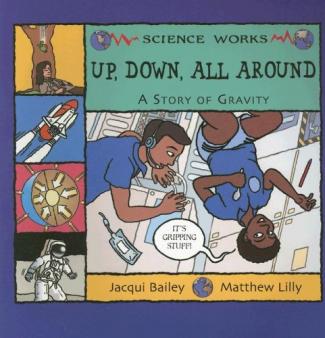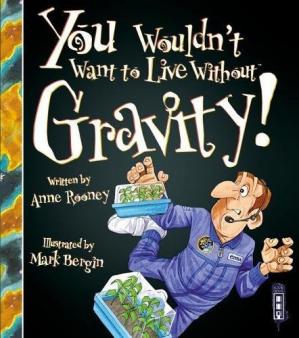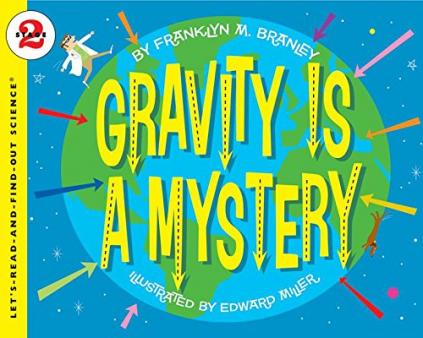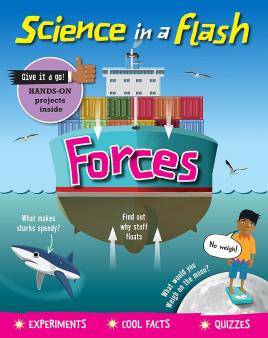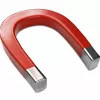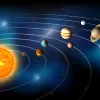Gravity

What is gravity?
Gravity attracts all objects towards each other. Gravity has been around since the very beginning of the universe, and it works the same way everywhere in the universe, on all kinds of different objects, of all different sizes (larger than atoms – those are held together by atomic forces instead).
How much gravity an object has depends on how big it is (or to be specific, how much mass it has). It also depends on how close you are to the object; the closer you are, the stronger the gravity.
Gravity is very important to our everyday lives. Without Earth's gravity we would fly right off our planet! We'd all have to be strapped down all the time and if you kicked a ball, it would fly off forever. While it might be fun to try for a few minutes, we certainly couldn't live life on Earth without gravity.
Gravity also is important on a larger scale. It is the Sun's gravity that keeps the Earth in orbit around the Sun. Life on Earth needs the Sun's light and warmth to survive. Gravity helps the Earth to stay just the right distance from the Sun, so it's not too hot or too cold.
Nobody fully understands how gravity works, or even why gravity exists. One way of looking at gravity is to think of it not as a force like magnetism, but instead as a natural result of the way mass bends space. Any object with mass (like a star) pushes on space and bends it, so that other objects (like planets) that are moving in a straight line are also going around the star. It looks to us like the star is pulling on the planet, but really the star is bending space.
Top 10 facts
- The bigger the object's mass, the more gravity it will have; the smaller the mass of the object, the less gravity it is subject to.
- Gravity guides the growth of plants and other vegetation.
- Black holes have the strongest gravitational pull in the entire universe.
- The Earth is a giant magnet. Its magnetic field is like a bar magnet at its centre.
- Sir Isaac Newton discovered gravity about 300 years ago. The story is that Newton saw an apple fall out of a tree. When this happened he realised there was a force that made it occur, and he called it gravity.
- Ocean tides are caused by the gravity of the moon.
- If you could travel from planet to planet your mass would stay the same, but your weight would vary depending on how the gravity of that planet pulled on you. Mars is smaller and has less mass than Earth and as a result it has less gravity. If you weigh 100 pounds on Earth, you would weigh 38 pounds on Mars.
- At some point when falling, the friction from the air will equal the force of gravity and the object will be at a constant speed. This is called the terminal velocity. For a sky diver this speed is around 100 miles per hour!
- We don't actually "feel" gravity. We only feel the effects of trying to overcome it by jumping or when we fall.
- Gravity always pulls, it never pushes.


Boost Your Child's Maths & English Skills!
- Start your child on a tailored learning plan
- Complete the activities added each week
- Watch your child's maths & English confidence grow!
Did you know?
- You are shrinking right now. Every day you are taller in the morning than you are at night. In fact, at the end of each day you are about 1/2 inch (1.25 centimetres) shorter than when you got up that morning. If you don't believe it, have someone measure you when you get up in the morning and then again before you go to bed. This isn't because your heavy backpack has weighed you down. It happens because of gravity. As you walk around during the day, gravity is pulling you down, or more correctly, toward the centre of Earth. Lying down to sleep at night gives your spine a chance to stretch back to your full height.
- On Earth, gravity isn't entirely even. Because the globe isn't a perfect sphere, its mass is distributed unevenly, which means slightly uneven gravity.
- One mysterious gravitational anomaly is in the Hudson Bay of Canada. This area has lower gravity than other regions, and a 2007 study found that now-melted glaciers were to blame. The ice that once covered the area during the last Ice Age has long since melted, but the Earth hasn't entirely snapped back from the burden. Since gravity over an area is proportional to the mass on top of that region, and the glacier's imprint pushed aside some of the Earth's mass, gravity is a bit less strong in the ice sheet's imprint. The slight deformation of the crust explains the unusually low gravity in the area. In some places, it’s almost half as strong as it is elsewhere!
- Black holes are some of the most destructive objects in the universe, named because nothing, not even light, can escape their gravitational clutches. At the centre of our galaxy is a massive black hole with the mass of 3 million suns. The black hole isn't really a danger to us Earthlings – it's both far away and it's remarkably calm.
- In the very beginning of the universe, after the Big Bang, gravity pulled atoms together to make stars and planets. Once the stars and planets had formed, gravity kept the planets in orbit around the stars, and moons orbiting around the planets. And on each planet that is large enough, gravity keeps an atmosphere around the planet.
- On Earth, gravity keeps the air around us (and everything else) from drifting off into space. Gravity also causes hot air to rise while colder air falls (which in turn causes wind).
Gravity gallery:
- Astronauts dealing with a lack of gravity!
- As skydivers fall to Earth the force pulling them down is gravity.
- Gravity holds the moon in orbit around Earth
- All objects fall at the same rate – air resistance affects this speed.
- Items with a different mass fall at the same rate in a vacuum.
- It is said that Sir Isaac Newton wrote his theory about gravity after watching an apple fall to the ground.
- A portrait of Sir Isaac Newton.
Gallery
About
Gravity or gravitational forces are forces of attraction. It's like the Earth pulling on you and keeping you on the ground. That pull is gravity at work.
Every object in the universe that has mass exerts a gravitational pull, or force, on every other mass. The size of the pull depends on the masses of the objects. You exert a gravitational force on the people around you, but that force isn't very strong, since people aren't very big. When you look at really large masses, like the Earth and Moon, the gravitational pull becomes very impressive. The gravitational force between the Earth and the molecules of gas in the atmosphere is strong enough to hold the atmosphere close to our surface. Smaller planets, that have less mass, may not be able to hold an atmosphere.
A larger size does not mean a bigger mass. Imagine two balls that are about the same size, like a football and a bowling ball. Will they have the same mass? No.
An easy way to think about mass is to consider how much matter or "stuff" you can find inside the object. The amount of matter in the object will affect how heavy it is, meaning gravity has plenty of matter to ‘grab onto’. In the case of the football, air molecules make up most of its inside. The outside of the ball looks solid, but cut it in half and the ball will look like an empty shell. Whereas the inside of a bowling ball is usually completely solid, so if you cut it in half you will end up with two solid pieces. The bowling ball has more matter inside it, making it denser than the football. Therefore, its mass will be greater than the soccer ball's mass.
Mass is measured in grams (g) or kilograms (kg) but is NOT a force. The weight of an object is the force caused by gravity pulling down on the mass of an object. It is measured in newtons (N). Weight is measured using a force meter. The bigger the weight attached to the force meter, the more the spring inside the force meter stretches.
The Earth always produces the same acceleration on every object. If you drop an acorn or a piano, they will gain velocity (speed) at the same rate. Although the gravitational force the Earth exerts on the objects is different, their masses are just as different, so the effect we observe (acceleration) is the same for each. The Earth's gravitational force accelerates objects when they fall. It constantly pulls, and the objects constantly speed up. You might be thinking, "What about feathers? They fall so slowly." Obviously, there is air all around us. When a feather falls, it falls slowly because the air is in its way. There is a lot of air resistance and that resistance makes the feather move more slowly. The forces at work are the same. If you dropped a feather in a container with no air (a vacuum), it would drop as fast as a baseball.
Isaac Newton was an incredibly clever man. He was a scientist and a mathematician. In 1687, Newton published a book about mathematics which is thought to be one of the important books in the history of science. In it he describes universal gravitation and the three laws of motion, concepts that remained at the forefront of science for centuries after. Newton was known to have said that his work on formulating a theory of gravitation was inspired by watching an apple fall from a tree and wondering about what made it fall downwards.
Words to know:
Universe - all matter and energy that exists in the vastness of space, whether known to human beings or not
Gravity - the attraction due to gravitation that the Earth or another astronomical object exerts on an object on or near its surface
Atoms - the smallest portion into which an element can be divided
Mass - an object has mass (say 100 kg).This makes it heavy enough to weigh 100 kg
Orbit - the path that an astronomical object such as a planet, moon, or satellite follows around a larger astronomical object such as the Sun
Magnetism - the phenomenon of physical attraction for iron, found in magnets or made by a moving electric charge or current
Friction - the rubbing of two objects against each other when one or both are moving
Anomaly - something strange and difficult to identify or classify
Deformation - the act or process of damaging, disfiguring, or spoiling the look of something, or the condition of being damaged, disfigured, or spoiled
Denser - closer together, more tightly-packed
Newtons - The correct unit for measuring force is the Newton, which is abbreviated N.
Force meter - Force meters contain a spring connected to a metal hook. The spring stretches when a force is applied to the hook. The bigger the force applied, the longer the spring stretches and the bigger the reading.
Velocity - the speed at which something moves or happens
Concepts - ideas or principles
Related Videos
Just for fun...
- A tricky gravity game for older children
- Another good game to illustrate gravity
- Find out what you would weigh on other planets
- Try some at-home investigations that create microgravity conditions
- Make a gravity spinner toy
- Experiments to help you find the centre of gravity using paper airplanes and rulers
Best kids' books about gravity
Find out more about gravity:
- A kids' guide to gravity
- Watch BBC Bitesize clips about gravity
- How gravity works
- Watch an animation about gravity and have a go with a gravity simulator
- Find out about microgravity
- See videos for kids about how gravity pulls things down and how the gravitational forces between objects work
See for yourself
Try some practical science experiments: understand more about gravity and explain what you know or try one of TheSchoolRun's at-home science experiments (Experiments and science fun for KS1 and KS2, a subscriber resource).
Watch Expedition 16 flight engineer Dan Tani discuss and demonstrate gravity and Newton's laws from the International Space Station on the NASA website
Also see

Give your child a headstart
- FREE articles & expert information
- FREE resources & activities
- FREE homework help







